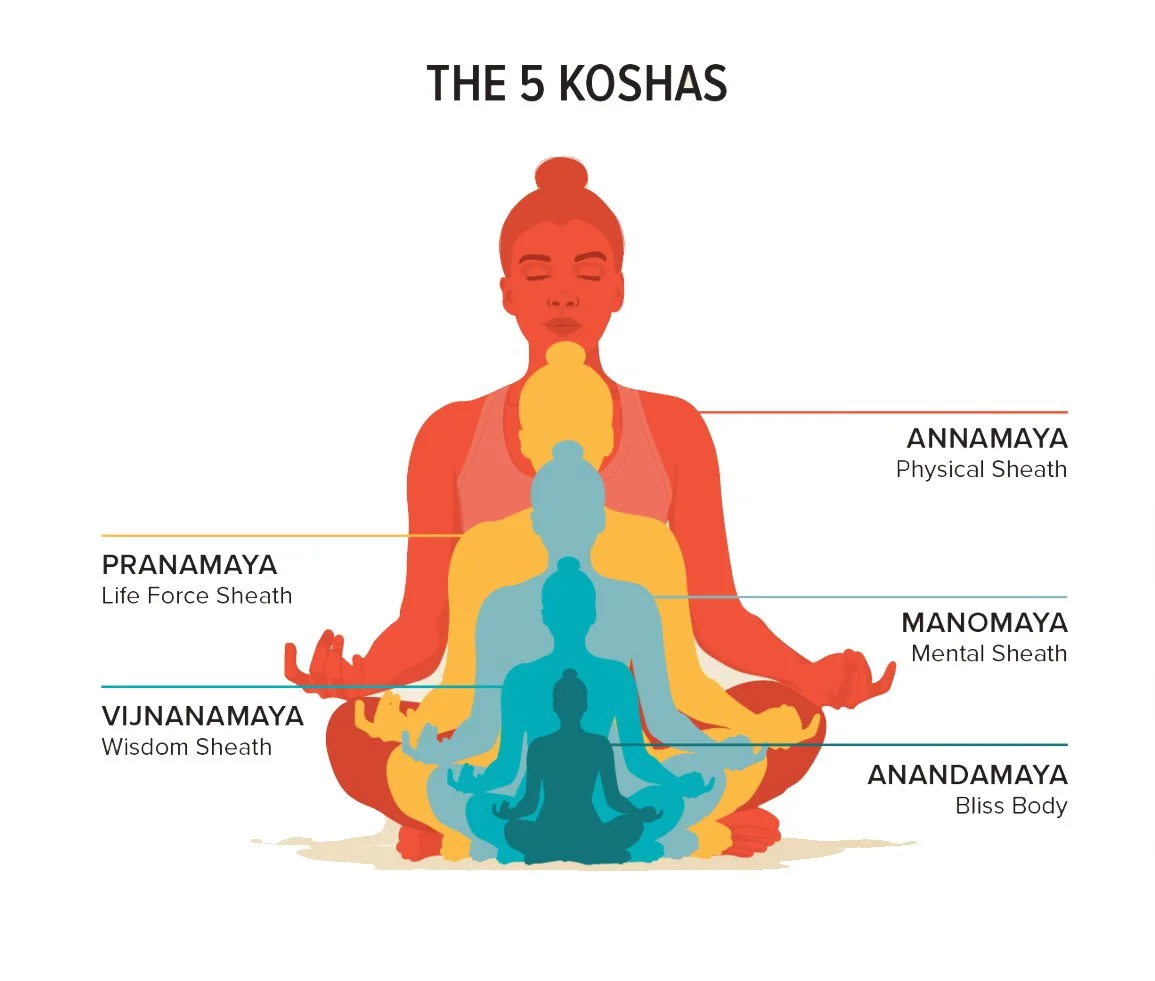Five Koshas
The Five Koshas and Their Relationship to Yoga Nidra
In the expansive realm of yogic philosophy, the notion of the Koshas, or sheaths, provides deep insights into the human experience. These five Koshas encapsulate distinct layers of existence, each playing a vital role in shaping our overall sense of self and consciousness. Each layer invites you to explore their relationship with the body, energy, mind, wisdom, and bliss.
By comprehending these layers, we can more effectively navigate the intricacies of our physical, energetic, mental, and spiritual lives, as well as enhance our experience of Yoga Nidra. The five Koshas are:
Annamaya Kosha (Physical Sheath)
The Annamaya Kosha is the outermost layer, representing the physical body. It is composed of the elements of earth, water, fire, air, and ether, and is nourished by food (anna). In the context of Yoga Nidra, relaxation of the physical body is essential. You are guided to release tension and become aware of bodily sensations, allowing for a deeper connection to inner stillness. By recognising the Annamaya Kosha, one can cultivate a sense of grounding and safety, creating a foundation for deeper exploration of the self.
Pranamaya Kosha (Vital Energy Sheath)
Beyond the physical body lies the Pranamaya Kosha, which encompasses the life force or prana that animates us. This sheath includes the breath and the energy channels (nadis) that flow within the body. In Yoga Nidra, you focus on the breath as a means to access this vital energy. Techniques such as pranayama and awareness of breath patterns help to harmonise the Pranamaya Kosha, fostering a sense of vitality and balance. As you settle into a state of deep relaxation, the flow of prana can be enhanced, leading to rejuvenation and healing.
Manomaya Kosha (Mental Sheath)
The Manomaya Kosha represents the mind and its functions, including thoughts, emotions, and perceptions. This layer is often the most active during waking life, filled with distractions and mental chatter. In Yoga Nidra, the aim is to quiet the mind and observe thoughts without attachment. Through guided visualisations and affirmations, you learn to navigate the Manomaya Kosha, fostering a sense of clarity and calm. This process allows individuals to recognise the transient nature of thoughts and emotions, helping them cultivate a more peaceful mental state.
Vijnanamaya Kosha (Wisdom Sheath)
The Vijnanamaya Kosha is the sheath of wisdom and intellect. It encompasses our intuition, discernment, and deeper understanding of reality. In the context of Yoga Nidra, this layer invites you to connect with your inner wisdom and higher self. By engaging in self-inquiry and reflection during the practice, individuals can access insights that transcend the limitations of the mind. This connection to the Vijnanamaya Kosha fosters a sense of purpose and alignment with one’s true nature, guiding practitioners towards self-realisation.
Anandamaya Kosha (Bliss Sheath)
The innermost layer, the Anandamaya Kosha, represents pure bliss and the experience of oneness. This sheath is often described as the state of deep peace and joy that is inherent in all beings. In Yoga Nidra, the journey through the Koshas culminates in the experience of the Anandamaya Kosha. As you relax deeply, you may encounter profound states of bliss and connection with the universal consciousness. This experience reinforces the understanding that beyond the layers of physical and mental existence lies a fundamental essence of joy and unity.
The Integration of Koshas in Yoga Nidra Practice
The practice of Yoga Nidra serves as a bridge that connects the five Koshas, facilitating a holistic experience of self-awareness and transformation. Each layer invites practitioners to explore their relationship with the body, energy, mind, wisdom, and bliss. By deliberately navigating through the Koshas, individuals can achieve a state of deep relaxation and profound insight.
During Yoga Nidra, participants are guided to visualize and experience each Kosha, allowing for a comprehensive integration of their being. This process not only promotes relaxation but also encourages healing on physical, emotional, and spiritual levels. The practice cultivates a greater understanding of oneself, fostering a sense of wholeness and interconnectedness.
Conclusion
The five Koshas provide a framework for understanding the complexity of human existence. Through the lens of Yoga Nidra, you can explore these layers with intention, leading to a deeper connection with yourself and the world around you. As you journey through the physical, energetic, mental, intellectual, and blissful sheaths, you uncover the essence of your being, ultimately experiencing the profound peace that resides within.
The integration of the Koshas in Yoga Nidra not only enhances the practice but also empowers you to embrace your true nature, fostering growth, healing, and transformation. Understanding the Koshas deepens your engagement with Yoga Nidra, allowing you to experience each layer of your being.
By exploring these sheaths, you can cultivate a more comprehensive awareness of yourself, enriching your practice and enhancing the profound benefits of Yoga Nidra. This exploration invites you to connect with the physical, energetic, mental, intellectual, and blissful aspects of your existence, creating a holistic framework for relaxation and self-discovery as you journey inward.
The Koshas represent different layers of our existence, each contributing uniquely to our overall sense of self. By delving into these layers, we can better navigate the complexities of our physical, energetic, mental, and spiritual lives.


